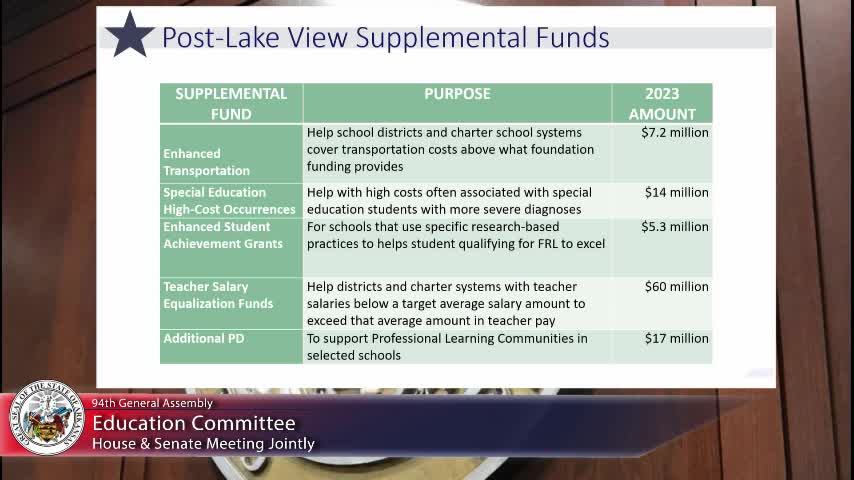Arkansas funding report details $193M plan for teacher salaries and tutoring support
February 06, 2024 | EDUCATION COMMITTEE - SENATE, Senate, Committees, Legislative, Arkansas

This article was created by AI summarizing key points discussed. AI makes mistakes, so for full details and context, please refer to the video of the full meeting. Please report any errors so we can fix them. Report an error »

In a recent meeting of the Arkansas Senate Education Committee, significant discussions centered around the allocation and impact of educational funding, particularly in light of new financial resources introduced through the Lawrence Act. The committee reviewed a substantial $193 million earmarked for schools to support teacher salaries, maternity leave, and merit pay, alongside additional funds designated for tutoring services and higher education programs.
The meeting highlighted the complexities of educational funding in Arkansas, with committee members questioning how these funds are being utilized and their correlation to educational outcomes. Senator Hammer raised concerns about the relationship between educational spending and broader social metrics, such as reductions in Medicaid recipients and incarceration rates, suggesting a need for further research into these connections. This inquiry reflects a growing interest in understanding how educational investments can influence societal well-being.
Another focal point was the effectiveness of different funding models. Senators questioned whether hybrid funding approaches yield better educational outcomes compared to traditional per-pupil funding methods. The committee acknowledged the lack of comprehensive analysis on this topic, indicating a gap in available data that could inform future funding strategies.
The discussions also touched on the disparities in funding allocation, particularly regarding preschool programs embedded within school districts. It was noted that while $35 million was allocated for preschools, only a fraction came from foundation funding, raising questions about the sources of the remaining funds and the financial pressures on school districts to supplement these programs.
As the meeting progressed, members expressed a desire for more detailed data on how funding correlates with educational outcomes, particularly for schools that do not adhere to foundation funding recommendations. The committee recognized the importance of understanding these dynamics to make informed decisions that could enhance educational quality across the state.
In conclusion, the Senate Education Committee's meeting underscored the critical need for ongoing analysis of educational funding and its impact on student outcomes. As Arkansas navigates these financial complexities, the committee's commitment to exploring these issues will be vital in shaping effective educational policies moving forward. The next steps will involve gathering more data and potentially revisiting funding models to ensure that resources are effectively supporting Arkansas's educational goals.
The meeting highlighted the complexities of educational funding in Arkansas, with committee members questioning how these funds are being utilized and their correlation to educational outcomes. Senator Hammer raised concerns about the relationship between educational spending and broader social metrics, such as reductions in Medicaid recipients and incarceration rates, suggesting a need for further research into these connections. This inquiry reflects a growing interest in understanding how educational investments can influence societal well-being.
Another focal point was the effectiveness of different funding models. Senators questioned whether hybrid funding approaches yield better educational outcomes compared to traditional per-pupil funding methods. The committee acknowledged the lack of comprehensive analysis on this topic, indicating a gap in available data that could inform future funding strategies.
The discussions also touched on the disparities in funding allocation, particularly regarding preschool programs embedded within school districts. It was noted that while $35 million was allocated for preschools, only a fraction came from foundation funding, raising questions about the sources of the remaining funds and the financial pressures on school districts to supplement these programs.
As the meeting progressed, members expressed a desire for more detailed data on how funding correlates with educational outcomes, particularly for schools that do not adhere to foundation funding recommendations. The committee recognized the importance of understanding these dynamics to make informed decisions that could enhance educational quality across the state.
In conclusion, the Senate Education Committee's meeting underscored the critical need for ongoing analysis of educational funding and its impact on student outcomes. As Arkansas navigates these financial complexities, the committee's commitment to exploring these issues will be vital in shaping effective educational policies moving forward. The next steps will involve gathering more data and potentially revisiting funding models to ensure that resources are effectively supporting Arkansas's educational goals.
View full meeting
This article is based on a recent meeting—watch the full video and explore the complete transcript for deeper insights into the discussion.
View full meeting
